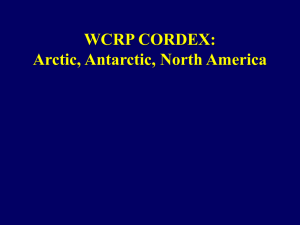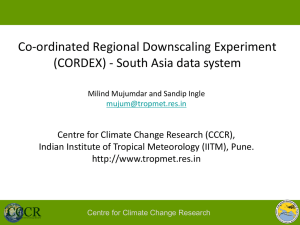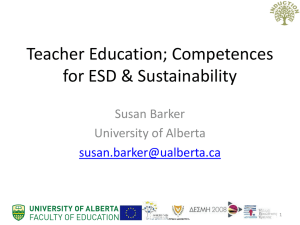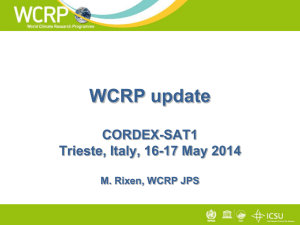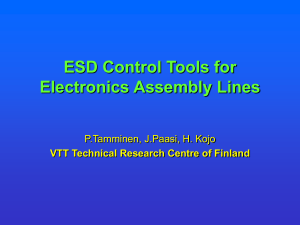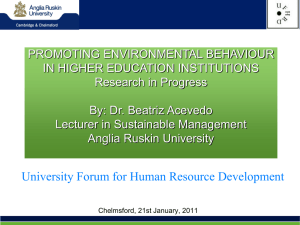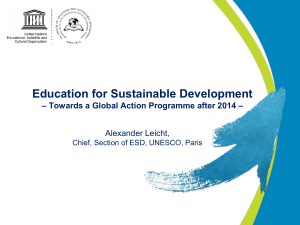Statistical Downscaling in CORDEX II
advertisement
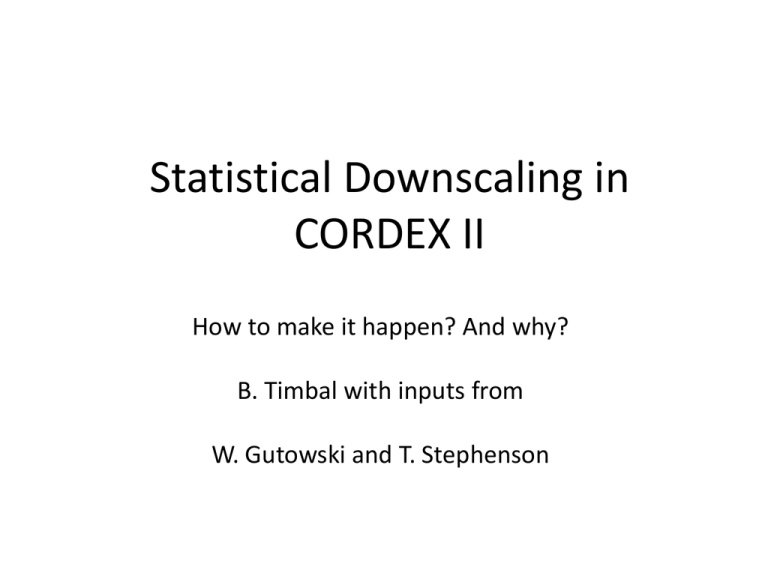
Statistical Downscaling in CORDEX II How to make it happen? And why? B. Timbal with inputs from W. Gutowski and T. Stephenson Overview • • • • • ESD workshop(s) Inter-comparison framework Scoping document (draft form) ESD challenges Implications for CORDEX ESD Workshop 1 26-27 Sept 2013 - ICTP, Trieste, Italy - 19 invited participants + 6 additional - from 14 countries (6 continents) CORDEX ESD Workshops - objectives 1) Design a downscaling experiment to facilitate ESD’s contribution to the combination matrix of GCM / RCM / ESD for a given RCP 2) Develop at least some minimum requirements for ESD output that is user relevant and which also allows for direct comparison of ESD and RCM climate projections 3) Agree on a set of metrics that allow cross-method ESD evaluation 4) Decide on common time and spatial resolution, training and test data, and regional foci 5) Extend the controlled vocabulary and quality control procedures to allow for publishing data on the Earth System Grid alongside the GCM and RCM results. CORDEX ESD Workshops - objectives 6) Agree on specific data formats for data sharing and distribution 7) Collate and complete relevant metadata on the ESD methods 8) Coordinating the CORDEX ESD activities with related initiatives occurring around the world (e.g., COSTVALUE, ISENES2, NCPP, etc.) 9) Ideally provide a set of examples/case studies of the use of ESD results, including evaluation of the results 10) Explore funding opportunities to leverage these core activities ESD Workshop 2 30th July to 1st Aug 2014 - Buenos Aires, Argentina - 22 invited participants (6 continents) - Further planning / start on inter-comparison - http://www-atmo.at.fcen.uba.ar/cordex/ Upcoming CORDEX-ESD • Setting-up experiments for inter-comparison • Small array of stations world-wide (R, T) stating from the GSN network but with specific requirements (duration, missing data) and completed as required to cover the world evenly (and all CORDEX domains) • Couple (1, 2 may be more) regions with high density network (R) (called "clumps") • A region (probably only one) with gridded observations • What it would achieve • Bring ESD away from the application drive behind the development to a "MIP"-type approach • Achieve early visibility in the CORDEX world • Show how it could contribute to populate a matrix (GCM/Downscaling) but only for a few stations world-wide, a grid somewhere and a few clumps. 7 Session at CORDEX conference – Nov 2013 o o o o o o o o o o o o All talks included both ESD and RCMs. A range of different ESD approaches was presented. One talk on application – rest looking into the community. RCM is complimentary to ESD. ESD compares favorably to RCMs. Better for biases, more mixed for trends. ESD challenges: limited information and stationarity (also applicable to RCMs) Difficult to compare points to grids. Vulnerability to unstated and untested assumptions. Inclusion of stochastic component important (linear transfer functions) Can you recommend a subset of models? Fair comparison between ESDs and RCMs is with extreme indicators (none are tuned to these). Bias correction are valuable for making the results more usable, but corrections for the future are problematic. 3 obvious challenges • Size of dataset: – ESD outputs increase 50.000 times between CMIP3 and CMIP5 crop of outputs – Application "ready" dataset (!) • Limitations on predictands available – Well observed (length, completeness) variables – User needs are broader (full Atmosphere-LS coupling) • Station observation vs. grid – Real observation = ground truth – Heavy reliance on stations in climate impact applications – Gridded data provides the spatial coverage ESD outputs morphing into RCM comparable products ESD in CORDEX – Scoping document • CORDEX – ESD objectives – What are they – How they relate to the CORDEX wider objectives • ESD: existing science – State of the landscape – Issues faced by ESD developers – Evaluation techniques – Initiative to put forward in CORDEX-ESM Inputs / feedbacks appreciated ESD in CORDEX – Issues • CORDEX domains and sub-domains – What is the existing CORDEX domain relevance to ESD? Avoid ESD being a niche activity within CORDEX • Boundaries could be guideline for the predictors? • Unlikely / not meaningful to deliver predictands to full CORDEX domains – What bout the future sub-domains? • It is possible to generate predictands for them • Need to be well chosen (Data rich regions) • To that end would be good to have amongst POCs some ESD understanding (one POC identified per region?) – Comparison SDM / RCM • Sporadic only comparison are likely (see earlier slide on planned Intercomparison) in the short term (1-2 years) • Full blown comparisons (GCM/RCM/SDM matrices) are only likely across well chosen sub-domain in the mid-term (3-5 years) • Need to balance program perspective, scientific purpose and SDM community interest • How to make it happen – – – – Carefully plan the sub-domains POCs: have an ESD developer involve for each domain Review of the CORDEX web site Predictors: influence in an effective way the CMIP6 archiving (contribute to a CORDEX CMIP endorse MIPs)



